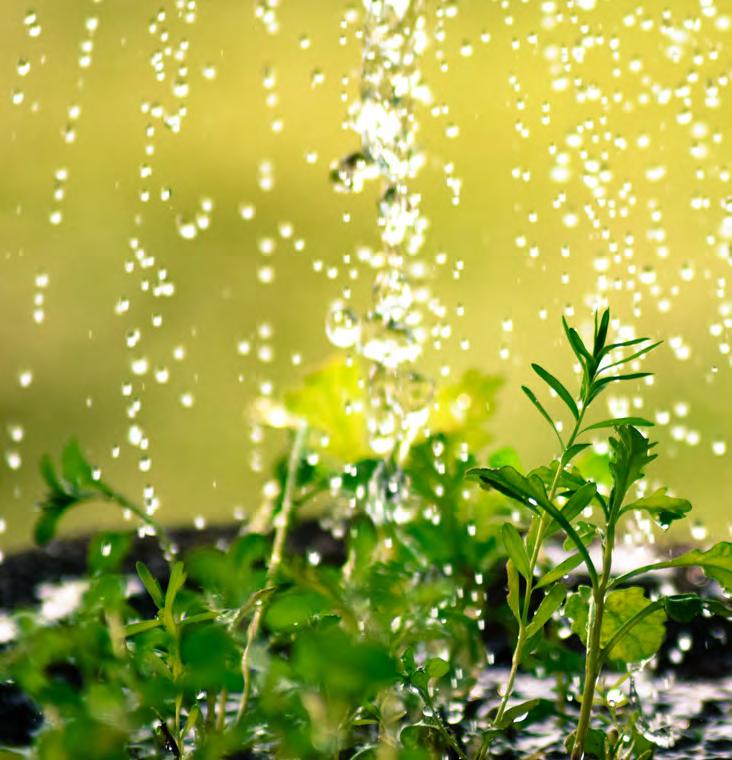
4 minute read
Irrigation Systems
How to choose the best options for your garden & your budget By Leanne Burkholder
As a landscape designer, I am often asked about watering by my clients—when? how much? how often? And, should I get an irrigation system?
The challenges with watering are higher today. Our summers are hotter and drier. What may have worked in the past may not work now. At the same time, people are busy and want lower maintenance gardens.
The right plants.
Before you go to the expense of installing an irrigation system, first choose the right plants for the right place in your garden. If you have a hot, sunny south-facing garden—choose plants that love that type of location. Examples include lavender, coneflowers, succulents, most grasses. These plants prefer hot, dry conditions and have similar water needs. Mixing in an Annabelle hydrangea, which needs consistently moist soil, may not be the best choice in this type of garden.
Consider the stage of your plants.
Plants need consistent watering when they are establishing, typically during the first two months, depending on the plant. Watering should be done regularly at intervals so that the soil is consistently moist (it crumbles in your hand). If the plants prefer drier conditions, then less watering is needed. Remember: well-established plants don’t need as much watering except during long, hot dry periods. Note that it is best to water as early as possible in the day as it is cooler, and water won’t evaporate as quickly.
Know your soil.
In parts of Toronto, the soil is clay; it is sandy in other areas. If you overwater in clay soil, the water may pool, and the plant roots may choke. In sandy soils, you will have the opposite problem. Amending the soil as much as possible can help balance soil conditions and manage water needs. Using an organic mulch in your garden can help too—not only does it help prevent weeds; it can also help retain moisture.
So, you’ve picked the right plants for your conditions, you’ve amended the soil as much as possible, and you’ve mulched. But because our summers are hotter and dryer, or you want to limit your maintenance, should you consider getting an irrigation system?
The short answer is to decide what is right for you, your garden and your budget.
(Note: There are landscape design firms that will not install plants without an irrigation system as part of their plant guarantee.)
THE OPTIONS
Consult an Expert:
If you want to install an irrigation system, it is best to talk to irrigation experts, whether you are installing your own system, or having a professional install. Irrigation systems today are sophisticated and come with many different options, so it is important to do your research and get quotes for comparison purposes.
Don’t forget to ask your installer about certifications, maintenance, warranties and insurance. And call before you dig! https://www.ontarioonecall.ca/
Key considerations in irrigation design are the amount of water pressure, water flow rate, frequency of watering, timing, type of soil and the geography of your lot (whether it is flat or sloped).

Pop-up sprinkler
Sprinkler heads:
One of the first decisions to make is what type of sprinkler head to choose. The number, height and type of sprinkler heads is determined by the size of your space and type of garden. Working with a professional can help you determine the right number and type for you. Here are some examples:
• Pop up – these are activated at the designated watering time
• Fixed spray heads – the most common type, fans out water over a certain area
• Rotary – typically used for lawns, these heads spray water in a circle pattern; these can be designed to fit certain spaces
• Mist – these spray heads disperse a mist in the garden, the main purpose is to keep moisture levels even.

Drip irrigation
Drip irrigation:
This is a system where tubing underneath the ground allows water to drip slowly at the root level which means less water is lost at the surface. The flow and level of water is calibrated. Drip irrigation is a good choice for perennial beds and plant containers.
Tree bags, rings and diapers are essentially forms of drip irrigation; they are a great method to provide consistent watering to establishing trees and shrubs
You can have more than one type of irrigation method. For instance, you may have rotating sprinkler heads for your lawns and a drip irrigation system in your shrub and perennial beds.
Irrigation systems come with a control panel that allows you to set the watering program you need. You can set the time, day and length of watering. Of course, like everything these days many systems can be controlled through an app on your phone, giving you the flexibility to change your watering program when you are away.
To avoid over or under watering, is important that your watering program is specifically calibrated for your particular garden needs.
Costs of irrigation systems:
Factors include lot size, the number and type of sprinkler heads, whether you include drip irrigation, and how much water you use. As an example, in 2020 one of my clients installed an irrigation system. It covered 670 acres, included a control panel (programmable with a phone app), drip system for hedges and perennial beds as well as six sprinkler heads for the lawn. The total cost was $2,500.
For more information on irrigation companies, check out Landscape Ontario https://horttrades.com/
Homestars https://homestars.com/ is also a good source to see customer reviews on installers.
Leanne Burkholder, of outdoorspacesbylmb.com, is a self-employed residential landscape designer in North Toronto.










